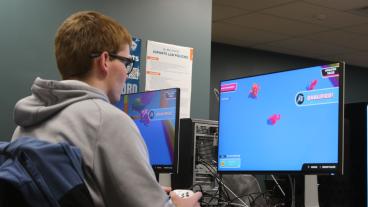In the sixth annual and largest NASA Robotic Mining Competition, a team of 14 Mines students will be competing against 53 teams from all over the nation to design and build a mining rover.
The senior design team, Blasterbotica, is taking apart last year’s rover and building new components to build a smaller rover for the competition May 18-22 at the Kennedy Space Center (KSC) in Florida. The rover will have to traverse a simulated Martian terrain, excavate regolith and gravel and deposit them into a collector bin within 10 minutes. The winning team will receive the Joe Kosmo Award for Excellence trophy, KSC launch invitations, team certificates for each member and a $5,000 team scholarship.
It’s unusual for teams to build a new rover instead of improving the previous team's rover, but Blasterbotica thinks this will give them an advantage.
“Ours will have a regolith delivery system made up of a bucket ladder and dumping system,” said David Long, mechanical engineering student. “We have created a unique method to lower the excavator, allowing it to go from perpendicular to vertical to almost horizontal. We can lower it in as deep as we want. This will give us a lot more mobility in terms of how we want to excavate.”
One of the challenges the team faces is staying within the weight and size limitations of the contest. The students received a donation from Lockheed Martin to fund their lightweight materials, such as aluminum and steel for the frame and polycarbonate for dust shielding and electronic boxes.
“It has to be durable because we want future teams to be able to use it,” said mechanical engineering student Nichole Cusack. “We will be using chains similar to ones you might see on a bucket ladder. This allows us to get better traction and turn easier so the treads don’t sink in.”
Last year, the team lost functionality in the rover during the competition because they used a faulty interface. To prevent that from happening again, the team will be using LINUX to allow for flexibility in driving the rover.
“We can’t sense the walls in the arena this year so we have to use inertial measurement units and camera vision to determine location,” said Long. “Power monitoring the rover is a big deal.”
The team is working quickly to have a build done by early April in order to have a month of testing. Since October, the team has delivered STEM presentations using previous rovers to area schools, such as Bell Middle School, Powderhorn Elementary School, Foothills Elementary School, Coal Creek Canyon Elementary School and Mitchell Elementary School.
Blasterbotica is comprised of students in the fields of mechanical engineering, electrical engineering and computer science. The team’s faculty advisors include mechanical engineering professors Christopher Dreyer and Ozkan Celik. Their client is Angel Abbud Madrid, director of the Center for Space Resources at Mines.
Visit blasterbotica.mines.edu to read more about the team. Keep up with the team’s progress on Facebook and Twitter.
The Senior Design Program is part of the College of Engineering & Computational Sciences, and is a creative multidisciplinary design experience emerging from combined efforts in civil, electrical, mechanical, and environmental specialties in engineering.
Contact:
Kathleen Morton, Communications Coordinator / 303-273-3088 / kmorton@mines.edu
Karen Gilbert, Director of Public Relations / 303-273-3541 / kgilbert@mines.edu



